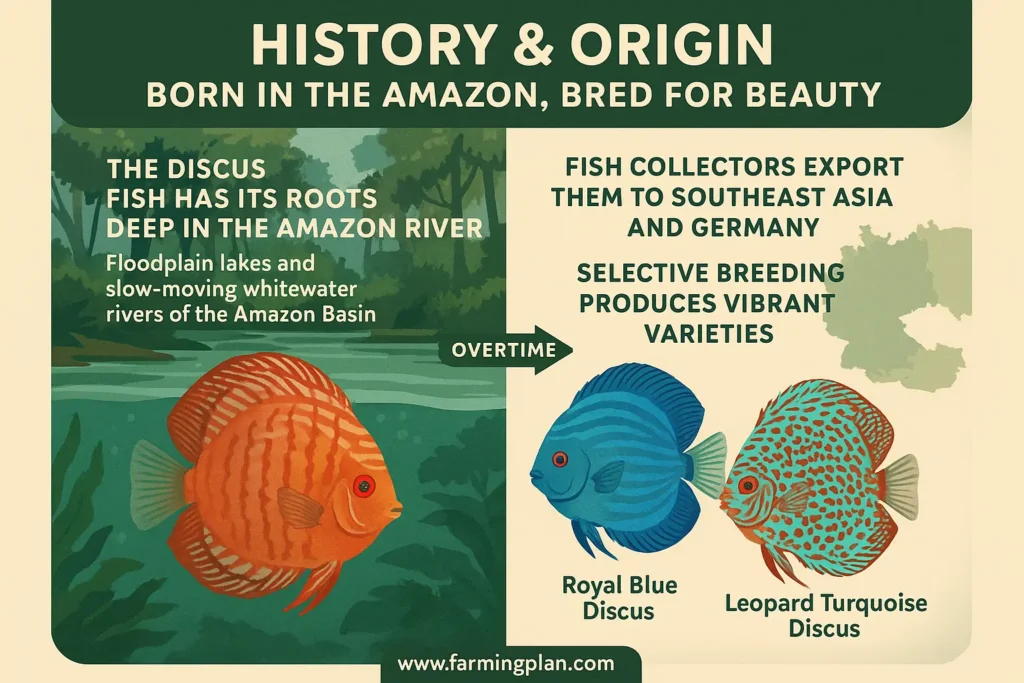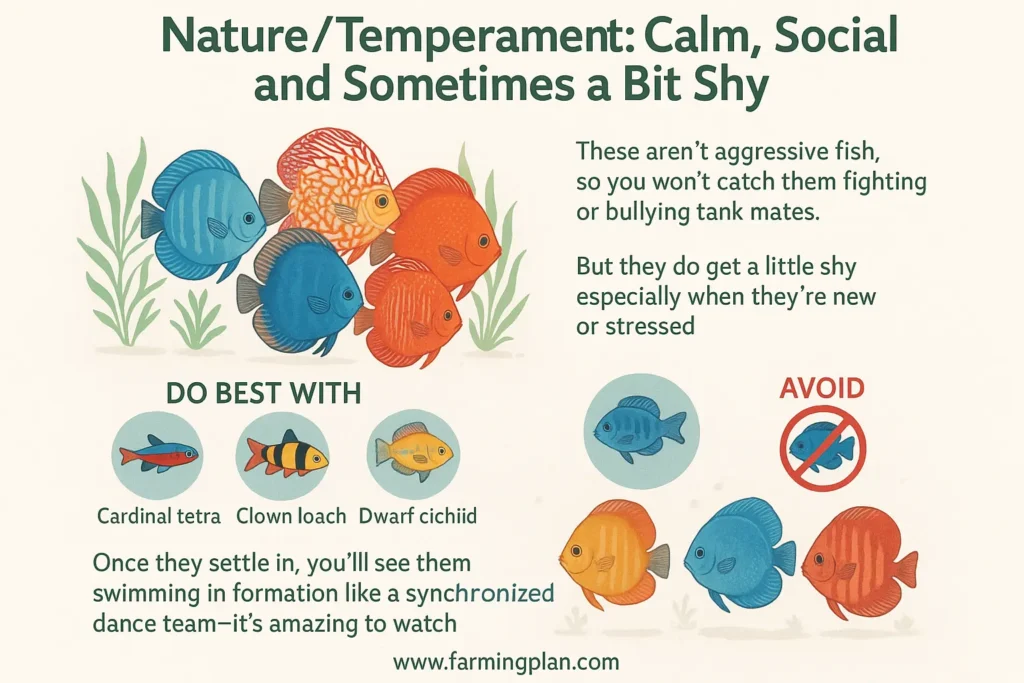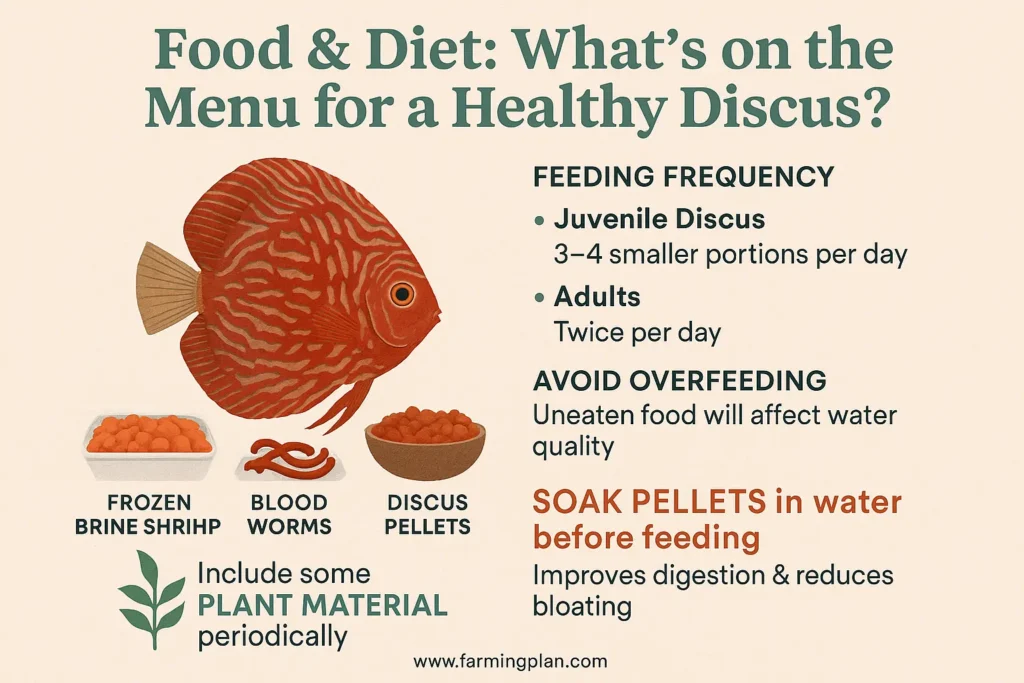If you’ve ever stared into a tank and felt totally mesmerized by a swirling, colorful school of fish chances are, you’ve seen a discus fish in action. These gorgeous, peaceful freshwater fish have a charm that’s hard to beat. I’ve been breeding and raising discus for years, and I can tell you they’re not just ornamental fish; they’re underwater royalty. From their graceful, rounded shape to their gentle nature, discus fish offer both beauty and personality. In this guide, I’ll walk you through everything I’ve learned feeding, behavior, care tips, and even breeding techniques so you can enjoy the same success (and joy) I’ve had with these stunning aquatic friends.

History & Origin: Born in the Amazon, Bred for Beauty
The discus fish has its roots deep in the Amazon River literally. These beauties hail from the floodplain lakes and slow-moving whitewater rivers of the Amazon Basin, especially near the Nanay River in Peru. Back then, wild discus lived in soft, acidic waters shaded by dense rainforest. That’s where their love for warm, pristine water comes from.

Over time, fish collectors started exporting them to places like Southeast Asia and Germany. That’s when things really took off. Pioneers like Jack Wattley who I personally admire played a huge role in selective breeding. Thanks to his work, today we have vibrant varieties like the Royal Blue Discus and Leopard Turquoise Discus. Whether you prefer wild discus or German-bred champions, their journey from the Amazon to your living room has been nothing short of amazing.
Characteristics: Rounded Grace in Every Glide
The first thing you’ll notice about discus fish is their shape almost perfectly circular. It’s what gives them that floating, gliding motion that’s so soothing to watch. Their colors? Oh man, they’re stunning. From the rich browns of the wild discus to the electric blues and fiery oranges of the Snakeskin and Leopard Turquoise types, there’s a style for everyone.
They’re not just pretty they’re symmetrical. Their body shape is designed for quick, bullet-like movements through water, which helps them dodge predators in the wild. These fish thrive in decorative aquariums with smooth gravel and lush plant material. Personally, I love pairing them with aquatic plants like Amazon Swords it gives the tank that jungle vibe that brings out their natural behavior.
Read More: Guppy Fish: The Most Beautiful and Reproductive Species
Nature/Temperament: Calm, Social, and Sometimes a Bit Shy
One of the things I love most about discus fish is their gentle, peaceful nature. They’re social creatures that prefer living in groups five or more if you’ve got the space. These aren’t aggressive fish, so you won’t catch them fighting or bullying tank mates. But they do get a little shy, especially when they’re new or stressed.

They do best with other peaceful species cardinal tetras, clown loaches, even dwarf cichlids. I always avoid pairing them with aggressive fish like African cichlids. That’s a recipe for disaster. Discus thrive when they feel safe, and trust me, a calm tank equals happy fish. Once they settle in, you’ll see them swimming in formation like a synchronized dance team it’s amazing to watch.
Food & Diet: What’s on the Menu for a Healthy Discus?
Feeding discus fish isn’t tricky but it’s gotta be right. These are high-maintenance eaters. I like to give mine a mix of frozen brine shrimp, bloodworms, and specially-formulated discus pellets. For the little guys (juvenile discus), I feed smaller portions 3–4 times a day. Adults? Twice is enough, as long as you’re offering rich, protein-packed meals.

Avoid overfeeding they’ll just leave uneaten food behind, and that messes with your water quality. I also toss in a bit of plant material from time to time. And here’s a tip: soak dry pellets in water before feeding. It makes them easier to digest and reduces bloating issues, which can be a big problem if ignored.
Read More: Platies: The Perfect Colorful Fish for Beginners
Usage/Purpose: More Than Just a Pretty Face
Discus fish are more than just eye candy. Sure, they’re the centerpiece fish in most freshwater tanks, but their use goes deeper. For breeders like me, raising true breeding pairs is a rewarding challenge. There’s an art to it, and when you see those tiny fry swimming around, it’s like watching your hard work come to life.
Fish farms also rely on discus for the ornamental fish market. Because of their high demand, they play a major role in the economics of fish farms worldwide. And let’s not forget the hobbyists they’re the ones creating gorgeous planted tanks with thriving discus schools. It’s a joy to watch.
Special Features: The Little Things That Make Discus Shine
Discus fish have some pretty unique features that set them apart. First, there’s their coloration no two fish look exactly alike. Even within the same strain, you’ll find different patterns, shades, and markings. That uniqueness is part of the fun of collecting them.
Then there’s their movement smooth, elegant, almost dancer-like. They’re speedy when they need to be but prefer to float around like they own the place. And let’s not forget their ability to form social bonds. I’ve had pairs that stick together for years, defending their turf and even raising their fry together. It’s beautiful to see such connection in fish.
Read More: Mollies Fish: Black and Speckled Yellow Colored Fish
Health Issues & Prevention: Keep Them Happy and Strong
Discus fish are sensitive. That’s both their charm and their challenge. They need pristine water no ammonia spikes, no sudden temp changes. The ideal water temperature? Between 82°F and 86°F. That’s tropical warm. Any cooler, and they start acting sluggish.
Watch for signs of stress like clamped fins, hiding, or darkened colors. Those can point to bacterial infections or internal parasites. Keep their tank clean, do 30–50% water changes weekly, and use a gravel filter to remove debris. I always recommend quarantining new fish for 14 days. Prevention saves you from costly treatments and a lot of heartache.
“A Happy Discus Is A Fast-Eating, Colorful Discus Give Them Warmth, Space, And Peace.”
Step-by-Step Pet Owner Care Guide: Raise Discus Like a Pro
Step 1: Choose the Right Tank Size
Start with nothing less than a 55-gallon tank, especially if you plan to keep a group. A 75-gallon aquarium is even better. These fish grow large and need swimming space. Plus, bigger tanks are easier to maintain stable water quality, which is crucial for discus.
Smaller tanks might seem easier, but they limit social behavior. Discus love to school, and without enough room, they can become shy or stressed. Trust me, a roomy tank pays off in the long run.
Step 2: Set Up Your Tank Like a Jungle Paradise
Use smooth-surfaced gravel, because rough substrates can harm their bellies. Add live aquarium plants like Java Ferns or Amazon Swords. They help keep the water clean and give your discus places to hide and explore.
Avoid strong filters that create currents. Go with a sponge filter or gentle HOB filter. These fish aren’t built for rapids—they like it calm and warm.
Step 3: Dial In Water Parameters
Keep the temperature between 82–86°F with a reliable heater. Use a digital thermometer to monitor it daily. The pH should be slightly acidic, around 6.0–6.5, and ammonia/nitrite levels must stay at zero.
I test water weekly using a simple kit. It helps me spot problems before they start. Stability is more important than perfection avoid sudden changes in any parameter.
Step 4: Pick Peaceful Tank Mates
Tank mates should be gentle and not outcompete discus for food. I recommend cardinal tetras, clown loaches, or dwarf cichlids. Avoid fast, aggressive fish that cause stress.
It’s also important to add tank mates after your discus have settled in. Otherwise, they might feel outnumbered and hide more often.
Step 5: Feed Like a Pro
Feed 2–3 times daily, mixing frozen foods, pellets, and occasional veggies. Juvenile fish need more frequent meals, while adults do just fine with two.
Watch them while they eat. A healthy discus will rush to food. If one starts lagging or refusing to eat, it could mean trouble better to act early than wait.
Step 6: Maintain That Water
Perform weekly 30–50% water changes using treated, temperature-matched water. Use a gravel vacuum to pull out waste from the bottom.
I keep a schedule Sundays are water change days in my house. It keeps the tank clean and my discus glowing with color.
Step 7: Breeding Tips for Success
If you’ve got a true breeding pair, set up a separate tank with a sponge filter and flat slate for egg laying. Raise the temp slightly and feed high-protein foods like brine shrimp.
The parents may guard the eggs and fan them for oxygen. If they eat the eggs early on don’t worry. It’s common for first-timers.
Expert Tips & Best Practices
- Always buy from reputable breeders or fish stores not random online suppliers.
- Keep the tank away from direct sunlight to avoid algae blooms.
- Feed live food once a week to boost immunity and activity.
- Quarantine all new fish even tank mates for at least 2 weeks.
- Use driftwood to lower pH naturally and mimic Amazon conditions.
FAQ
Are discus fish good for beginners?
They’re best for dedicated beginners or intermediate hobbyists. They need stable water and close attention.
Can discus live with other fish?
Yes, but only with peaceful tank mates like tetras or loaches that thrive in warm water.
How long do discus fish live?
With proper care, they live up to 10 years in a well-maintained aquarium.
Why is my discus fish turning dark?
Darkening often signals stress or illness check water quality and watch for disease signs.
How do I tell if my discus fish are breeding?
Look for a pair cleaning a flat surface or guarding a corner. That’s usually the first step.
Conclusion
Raising discus fish is a mix of art, science, and love. Their beauty, personality, and graceful nature make them a joy to keep, whether you’re a pet owner, breeder, or hobbyist. With the right setup, proper diet, and a little patience, you’ll soon have a tank full of happy, healthy, and colorful fish that truly steal the show.
